Potrebujeme váš súhlas na využitie jednotlivých dát, aby sa vám okrem iného mohli ukazovať informácie týkajúce sa vašich záujmov. Súhlas udelíte kliknutím na tlačidlo „OK“.
ASTM D6282/D6282M-14
Standard Guide for Direct Push Soil Sampling for Environmental Site Characterizations (Withdrawn 2023)
Automaticky preložený názov:
Štandardné príručka pre Direct Push pôdy pre odber vzoriek zo životného prostredia Site charakterizácia
NORMA vydaná dňa 1.5.2014
Informácie o norme:
Označenie normy: ASTM D6282/D6282M-14
Poznámka: NEPLATNÁ
Dátum vydania normy: 1.5.2014
Kód tovaru: NS-34514
Počet strán: 20
Približná hmotnosť: 60 g (0.13 libier)
Krajina: Americká technická norma
Kategória: Technické normy ASTM
Kategórie - podobné normy:
Anotácia textu normy ASTM D6282/D6282M-14 :
Keywords:
decontamination, direct push, groundwater, sealing, soil and sediment sampling, ICS Number Code 13.080.99 (Other standards related to soil quality)
Doplňujúce informácie
| Significance and Use | ||||||||||||||||||||||||||||||||||||||||||||||||||||
|
5.1 Direct Push Soil Sampling is used extensively in environmental site characterization of soils below ground surface and can also be used for subsurface geotechnical site characterization 5.1.1 Dual Tube Systems—Dual tube soil sampling systems are preferred for use because the bore hole is protected and sealed by the outer casing during operations. However, in some conditions when sampling below the groundwater, a sealed single tube sampler (5.1.2) must to be used to avoid sample cross contamination. Figure 1 shows how a Double Tube system is used. The outer tube stays in place to protect and seal the borehole and prevents potential cross contamination of the boring and the soil sample. Dual tube systems allow for rapid continuous sampling both above and below the water table. When sampling is not required, a sealed inner drive point can be locked in for driving through zones not targeted for sampling or through obstructions or difficult to sample formations. 5.1.1.1 Dual tube systems facilitate deployment of other testing and sampling systems (Test Method D1586 and Practice D1587) and sensors, groundwater sampling (D6001), water testing (D7242), and even monitoring well installations (D6724, D6725). Well installations may require use of specially designed expendable tips that facilitate well construction. 5.1.1.2 In larger Dual Tube systems with inside diameters of at least 75 mm the Standard Penetration Test (D1586) is often conducted in the bottom of the boring. Reliable SPT N values can be obtained in most soil formations that are not disturbed by the driving of the casing. Cohesionless sands and very soft clays may be disturbed during advancement of the Dual System to the test depth and should be evaluated or flagged if suspect. Reliable N values may not be obtained if there is evidence of heave or borehole instability from the base of the borehole to the inside the casing. 5.1.1.3 Dual tube systems are easily grouted and sealed for completion because the outer casing keeps an open sealed borehole for insertion of grout tubes. 5.1.1.4 As shown on Fig. 1, continuous sampling is done with an opening left at the bottom of the outer casing during the sampling process. This is fine as long as the formation is stable between sampling events. If there are heaving conditions into the outer casing the outer casing may be retracted to set the sampler barrel in position. The instability can be improved by maintaining a water level balance in the outer casing and using slower retraction of the sampler string during withdraw. If the material stability ids a problem then one must deploy a sealed single tube piston sampler (5.1.2) into the boring to retrieve samples. 5.1.1.5 A constant outer tube diameter of the Dual Tube system generally has more friction than some Single Tube rod driven samplers so may require larger equipment capable of higher more percussion and push forces. Dual Tube systems approaching 100 to 150 mm outside diameter have been developed and require larger direct push equipment. 5.1.2 Single Tube Systems—Sealed single tube samples assure that the soil sample is not cross contaminated by other soils or fluids inside the bore hole so they are preferred sampling method to use below groundwater. Single tube soil sampling systems are most often used for single incremental discrete soil sampling events but can also be used in continuous sampling modes with limitations listed below. Sealed piston type samples assure the best preservation of sample and assure no cross contamination of the soil. Figure 2 shows the basic operation of a single tube sampler. The sampler includes a sealed piston point to prevent soil intrusion during advancement to the target sample depth. The piston is then unlocked using various mechanisms and the sample is pushed to the design length. The complete sampler tube and drive rods are removed from the ground to retrieve the sample leaving an open hole after sampling. 5.1.2.1 The disadvantage to single tube sampling is that the hole left in the ground may not stay open and it would be difficult to grout if required. If positive proof of grouting is required it may be necessary to push a re-entry grout tube to the sample depth to grout the hole (D6001). Another disadvantage is possible travel of contaminants down the open hole. If cross contamination is a concern than a dual tube sampler system should be used. 5.1.2.2 Many single tube systems use drive rods of smaller diameter than the sampler body. The use of smaller diameter drive rods raises two concerns when sampling. First the soil above the sampler body may cave on the sampler and cause retraction problems. Second, if chemical analysis is required and the sampler will penetrate and cross contaminated zones there is concern that fluids from layers up above may run down the open annulus above the sampler causing cross contamination. 5.1.2.3 Single tube piston samplers are sometimes used in conjunction with Cone Penetrometer Testing (CPT) (D6067) and can be used in other geotechnical drilling (D6169) in the base of a drill hole. 5.1.2.4 Continuous Sampling operations may be conducted in the same hole with limitations. Using the sealed piston sampler, consecutive samples can be obtained in the same hole by re-driving the sealed piston sampler to a deeper target depths. 5.1.2.5 Open tube samplers without a piston (Fig. 3) should not be used except in rare cases. Use of an unsealed open barrel sampler without a sealed piston multiple times in the same sampling hole will result in cross contamination of samples from the hole wall, cave, and heaving. Continuous soil sampling using an open barrel is sometimes performed above the water table where boreholes are very stable. This sampling mode should never be used below the water table. A sealed sample is required to assure no cross contamination. 5.2 Direct push methods of soil sampling are used for geologic investigations, subsurface soil matrix contamination studies, and water quality investigations. Examples of a few types of investigations in which direct push sampling may be used include site assessments, underground storage tank investigations, and hazardous waste site investigations 5.3 Direct push methods can provide accurate information on the characteristics of the soils encountered and of the chemical composition if provisions are made to ensure that discrete samples are collected, that sample recovery is maximized, and that clean decontaminated tools are used in the sample gathering procedure. For purposes of this guide, “soil” shall be defined in accordance with Terminology D653. Using sealed or protected sampling tools, cased boreholes, and proper advancement techniques can assure good representative samples. Direct push boreholes may be considered as a supplementary part of the overall site investigation or may be used for the full site investigation if site conditions permit. As such, they should be directed by the same procedural review and quality assurance standards that apply to other types of subsurface borings. A general knowledge of subsurface conditions at the site is beneficial. 5.4 Soil strata profiling to shallow depths may be accomplished over large areas in less time than with conventional drilling methods because of the rapid sample gathering potential of the direct push method. More site time is available for actual productive investigation as the time required for ancillary activities, such as decontamination, rig setup, tool handling, borehole backfill, and site clean-up is reduced over conventional drilling techniques. Direct push soil sampling has benefits of smaller size tooling, smaller diameter boreholes, and minimal investigative derived waste. 5.5 The direct push soil sampling method may be used as a site characterization tool for subsurface investigation and for remedial investigation and corrective action. The initial direct push investigation program can provide good soil and sediment stratigraphic information depending on the soil density and particle size, determine groundwater depth, and provide samples for field screening and for formal laboratory analysis to determine the types and concentrations of chemical contaminants in the soil or sediments and contained pore fluids. The method does not provide samples for laboratory test if engineering properties (Class C and D D4220). 5.6 This guide may not be the correct method for investigations in all cases. As with all drilling methods, subsurface conditions affect the performance of the sample gathering equipment and methods used. Direct push methods are not effective for solid rock and are marginally effective in partially weathered rock or very dense soils. These methods can be utilized to determine the rock surface depth. The presence or absence of groundwater can affect the performance of the sampling tools. Compact gravelly tills containing boulders and cobbles, stiff clay, compacted gravel, and cemented soil may cause refusal to penetration. Certain cohesive soils, depending on their water content, can create friction on the sampling tools which can exceed the static delivery force, or the impact energy applied, or both, resulting in penetration refusal. Some or all of these conditions may complicate removal of the sampling tools from the borehole as well. Sufficient retract force should be available to ensure tool recovery. As with all borehole advancement methods, precautions must be taken to prevent cross contamination of aquifers through migration of contaminants up or down the borehole. Regardless of the tool size, the moving of drilling and sampling tools through contaminated strata carries risks. Minimization of this risk should be a controlling factor in selecting sampling methods and drilling procedures. The user should take into account the possible chemical reaction between the sample and the sampling tool itself, sample liners, or other items that may come into contact with the sample 5.7 In some cases this guide may combine water sampling, or vapor sampling, or both, with soil sampling in the same investigation. Guides D6001 and D4700, D7648 can provide additional information on procedures to be used in such combined efforts. D3740 provides evaluation factors for the activities in this standard. Note 1: The quality of the result produced by this standard is
dependent on the competence of the personnel performing it and the
suitability of the equipment and facilities used. Agencies that
meet the criteria of Practice D3740 are generally considered capable of
competent and objective testing/sampling/inspection/etc. Users of
this standard are cautioned that compliance with Practice
D3740 does not in itself
assure reliable results. Reliable results depend on many factors;
Practice D3740 provides a
means of evaluating some of those factors.
|
||||||||||||||||||||||||||||||||||||||||||||||||||||
| 1. Scope | ||||||||||||||||||||||||||||||||||||||||||||||||||||
|
1.1 This guide addresses direct push soil samplers, which may also be driven into the ground from the surface or through prebored holes. The samplers can be continuous or discrete interval units. Samplers are advanced by static push, or impacts from hammers, or vibratory methods, or a combination thereof, to the depth of interest. Both single tube and dual (double) tube systems may be advanced for soil sampling with direct push methods. Direct push methods are most often used to collect geo-environmental soil samples. These soil samples are used for soil classification (Practice D2488) and lithologic/hydrostratigraphic logging as well as being sub-sampled for contaminant and chemical analyses. 1.2 Other drilling and sampling methods may apply for samples needed for engineering and construction applications. This guide does not address single sampling events in the immediate base of the drill hole using rotary drilling equipment that employ cuttings removal as the sampler is advanced. Other sampling standards, such as Test Method D1586, Practices D1587 and D3550, and summarized in Guide D6169 apply to rotary drilling activities (Guide D6286). The guide does not cover open chambered samplers operated by hand such as augers, agricultural samplers operated at shallow depths, or side wall samplers. 1.2.1 While Sonic Drilling is considered a direct push method this standard may not apply to larger equipment addressed in Practice D6914. 1.3 Guidance on collection and handling of samples, are given in Practices D4220 and D6640. Samples for chemical analysis often must be subsampled and preserved for chemical analysis using special techniques such as Practice D4547, D6418, and D6640. Additional information on environmental sample preservation and transportation is available in other references 1.4 Insertion methods described include static push, impact, percussion, other vibratory/sonic driving, and combinations of these methods using direct push equipment adapted to drilling rigs, cone penetrometer units, and specially designed percussion/direct push combination machines. Hammers providing the force for insertion include drop style, hydraulically activated, air activated and mechanical lift devices. 1.5 Direct push soil sampling is limited to soils and unconsolidated materials that can be penetrated with the available equipment. The ability to penetrate strata is based on hammer energy, carrying vehicle weight, compactness of soil, and consistency of soil. Penetration may be limited or damage to samplers and conveying devices can occur in certain subsurface conditions, some of which are discussed in 5.6. Successful sample recovery also may be limited by the ability to retrieve tools from the borehole. Sufficient retract force must be available when attempting difficult or deep investigations. 1.6 This guide does not address the installation of any temporary or permanent soil, groundwater, vapor monitoring, or remediation devices. 1.7 The practicing of direct push techniques may be controlled by local regulations governing subsurface penetration. Certification, or licensing requirements, or both, may need to be considered in establishing criteria for field activities. 1.8 The values stated in either SI units or inch-pound units are to be regarded separately as standard. The values stated in each system may not be exact equivalents; therefore, each system shall be used independently of the other. Combining values from the two systems may result in non-conformance with the standard. 1.9 This standard does not purport to address all of the safety concerns, if any, associated with its use. It is the responsibility of the user of this standard to establish appropriate safety and health practices and determine the applicability of regulatory limitations prior to use. 1.10 This guide offers an organized collection of information or a series of options and does not recommend a specific course of action. This document cannot replace education or experience and should be used in conjunction with professional judgment. Not all aspects of this guide may be applicable in all circumstances. This ASTM standard is not intended to represent or replace the standard of care by which the adequacy of a given professional service must be judged, nor should this document be applied without consideration of a projects's many unique aspects. The word “Standard” in the title of this document means only that the document has been approved through the ASTM consensus process. |
||||||||||||||||||||||||||||||||||||||||||||||||||||
| 2. Referenced Documents | ||||||||||||||||||||||||||||||||||||||||||||||||||||
|
Podobné normy:
Historická
1.11.2009
Historická
1.8.2013
Historická
15.1.2013
Historická
1.9.2012
Historická
1.5.2011
Historická
1.11.2011


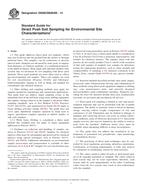
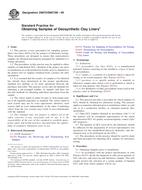 ASTM D6072/D6072M-09..
ASTM D6072/D6072M-09..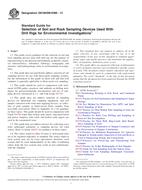 ASTM D6169/D6169M-13..
ASTM D6169/D6169M-13..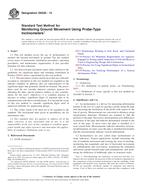 ASTM D6230-13
ASTM D6230-13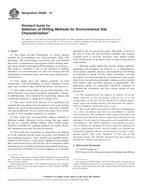 ASTM D6286-12
ASTM D6286-12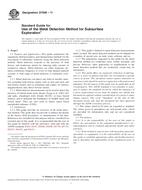 ASTM D7046-11
ASTM D7046-11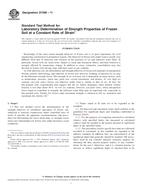 ASTM D7300-11
ASTM D7300-11
 Cookies
Cookies
